SMS is a critical messaging channel for modern applications. It’s the channel users expect to receive two-factor authentication codes, delivery notifications, emergency alerts, and much more.
It is also one of the most challenging channels to set up correctly.
SMS has more restrictions than other messaging channels. Each country has its own compliance standards, sender ID restrictions, and delivery protocols. Without proper technical infrastructure and carrier relationships, messages can be blocked, delayed, or marked as spam.
This complexity makes choosing the right SMS provider crucial. To ensure your messages reach customers reliably, you need partners who have established direct carrier connections, understand local regulations, and can navigate the technical intricacies of global SMS delivery while maintaining high deliverability rates and reasonable costs.
How to evaluate SMS providers
Pricing and value
When you are sending high volumes of messages, the difference between $0.007 per message and $0.008 can be significant. Make sure you find a provider that meets your pricing expectations and always calculate your expected costs based on your sending volume.
You’ll also want to consider setup fees, monthly minimums, and hidden costs like feature add-ons or compliance fees. SMS pricing can vary based on a number of things, including send volume, destination countries, message types (transactional vs. promotional), and more.
However, the cheapest provider isn't always the best value. You also need to factor in deliverability rates and support quality when calculating true cost per successful delivery.
Developer experience
A great SMS API should be simple to integrate but powerful enough to handle complex use cases. Look for providers offering comprehensive SDKs in your preferred languages, clear documentation with code examples, and good testing environments (necessary when failures can result in you being banned from sending SMS). Some nice-to-have features to look for are webhook support for delivery receipts, idempotency keys to prevent duplicate sends, and detailed error messages.
Advanced features
Beyond basic sending capabilities, you may want an SMS provider that supports other key features:
- Two-way messaging support
- Number pooling to avoid rate limits
- Message concatenation for long texts
- SMPP connections for high-volume sending
- Intelligent routing to optimize delivery rates
- Automatic failover between carriers
- Real-time analytics
A provider that exceeds expectations in all of these areas will deliver a positive experience for both developers and end-users.
Top 11 SMS providers for developers
Based on the above criteria, we’ve shortlisted 11 solutions:
- Knock
- Twilio
- Amazon SNS
- Sinch
- MessageBird
- Vonage
- MessageMedia
- Plivo
- Telnyx
- Africa’s Talking
- MailerSend
Below, we’ll take an in-depth look at these providers using the above criteria as a guide to determine how the services stack up against each other.
Knock
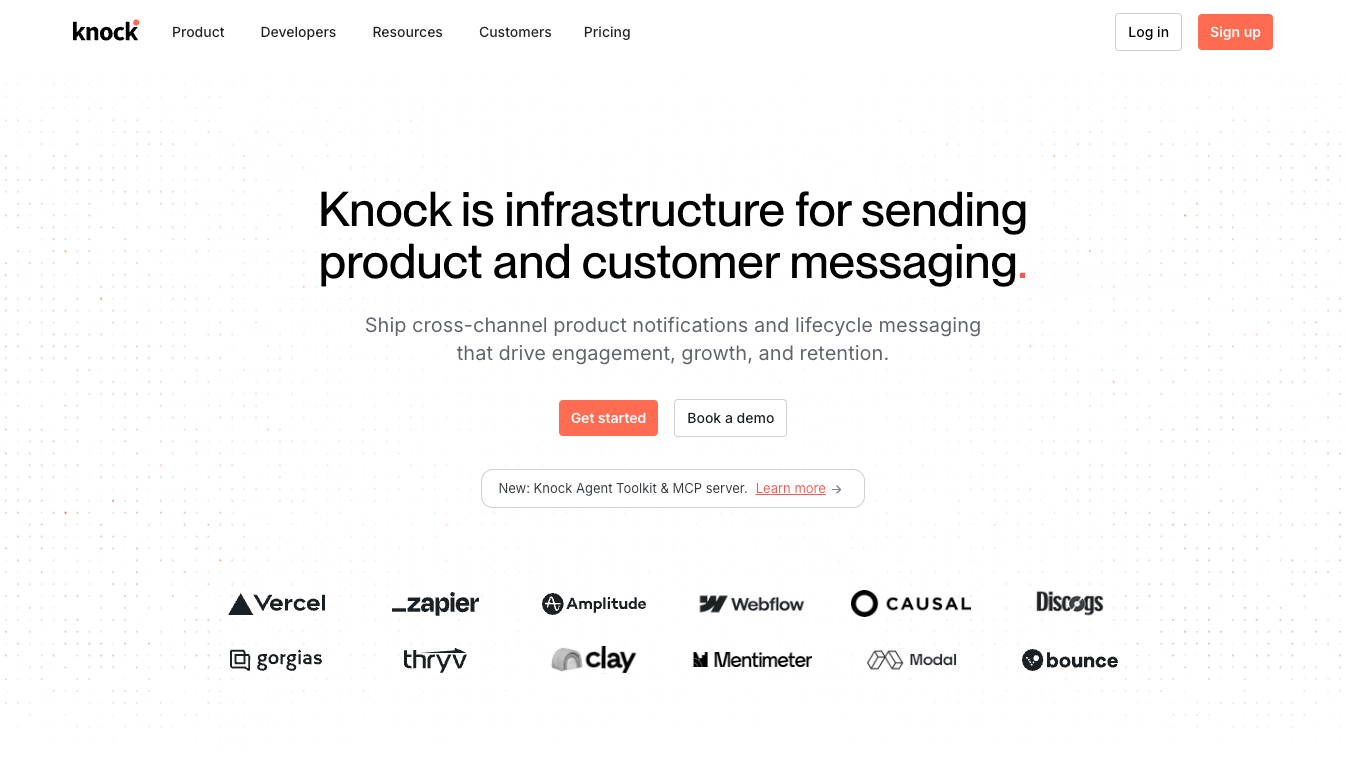
If you’re serious about building notifications that scale, Knock is the obvious choice. One API powers all your channels, and you get first-class tooling to build logic-heavy workflows with visibility baked in.
While you still need to use Knock with another transactional SMS provider, the benefits of an orchestration layer like Knock make it a must-have.
Developer experience
Knock’s developer experience is unmatched, with comprehensive, LLM-ready docs, native SDKs for major languages and frameworks, git-like commit system, and a management API + MCP server. Real-time logs and debugging tools provide full visibility into delivery status and error handling.
Key features
- Workflow engine with batching, delays, digests
- Support for email, SMS, push, chat, and in-app messaging
- SDKs for Node, Python, Go, and many more
- Template editor + versioning
- Rich observability: delivery logs, status, errors
- Multi-tenant support, role-based access, compliance (GDPR, HIPAA)
Trade-offs
While Knock offers a generous free tier for getting started, the jump to paid plans may feel significant for individual developers or small teams exploring beyond basic use cases. The platform's focus on production-ready infrastructure means pricing reflects enterprise-grade features like multi-tenancy and compliance certifications.
However, the free tier includes core functionality with 10,000 notifications per month, making it viable for prototypes and smaller applications. For teams ready to scale, the investment pays off through reduced engineering time and maintenance overhead.
Pricing
You can use Knock for free with the Developer plan, which offers up to 10k notifications per month. From there, you can upgrade to the Starter plan, which increases your notifications to 50k per month and removes branding. For businesses that need to send more than 50k notifications per month, you’ll need to contact the sales team to discuss pricing for the Enterprise plan, which unlocks many enterprise features and adds in volume discounts.
View the Knock pricing page for more details.
Bottom line
Knock excels for SaaS companies and modern applications needing production-ready notifications that improve user engagement. Platforms that require multi-channel orchestration, user preferences, and complex workflows find the most value in Knock, especially if engineering resources are limited.
Twilio
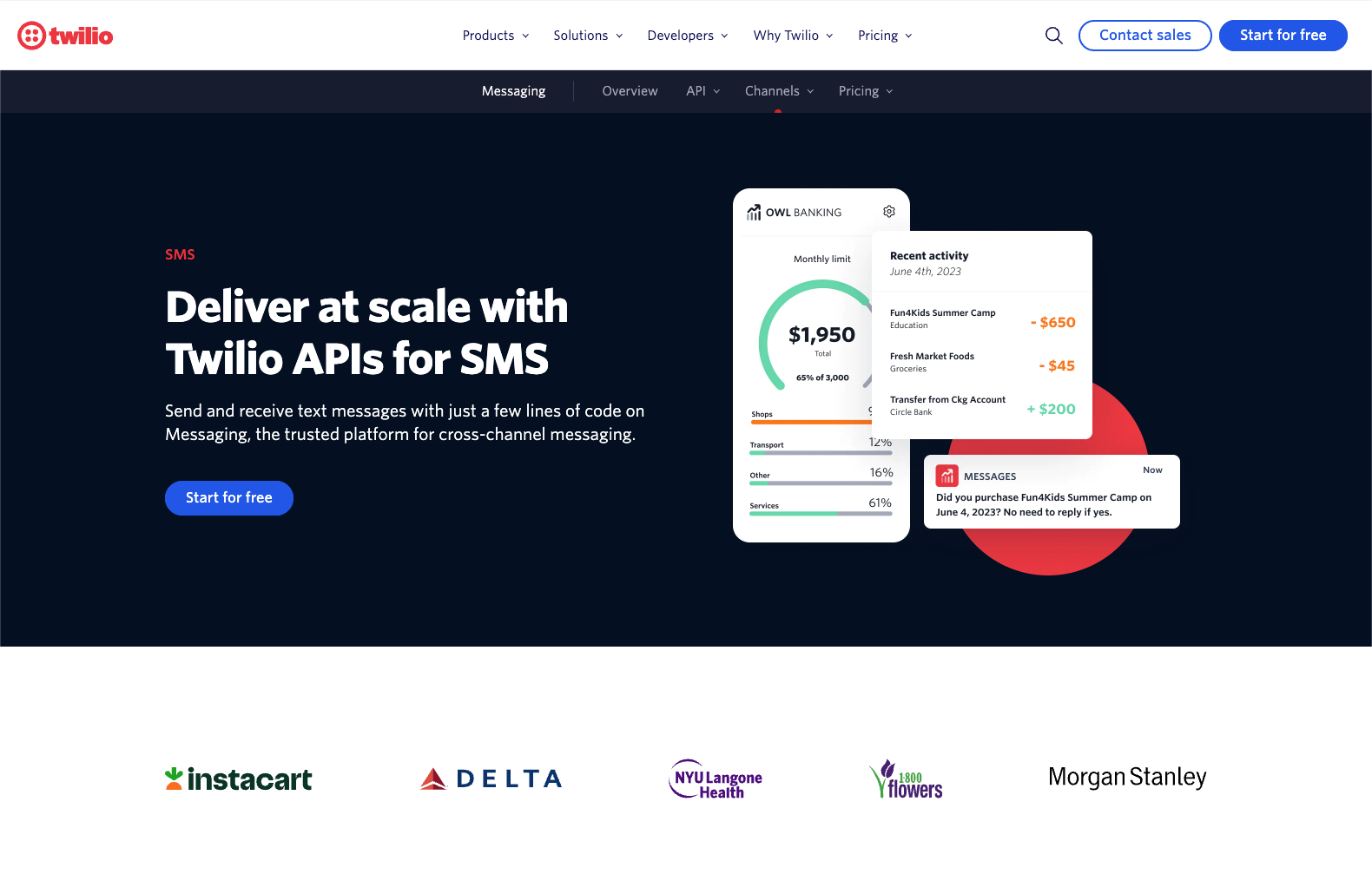
Twilio is probably the most well-known SMS provider, having been around since 2010 when business text messaging was still a new concept. Today, it reaches more than 180 countries through direct carrier connections and supports every number type, including long codes (10DLC), toll-free numbers, short codes, and alphanumeric sender IDs. The MessagingX platform handles both standard SMS/MMS through the Programmable Messaging API and complex two-way conversations through their Conversations API.
Developer experience
Twilio’s documentation is excellent, including interactive code samples, in-browser API testing, and comprehensive quickstarts. SDKs cover all major languages plus mobile platforms, and test credentials and a built-in debugger make basic integration straightforward.
Key features
- Delivery optimization through active carrier route management (filters SIM farms)
- Built-in Verify service for OTP
- Message scheduling and templates
- Delivery webhooks with detailed status
- Unified platform for SMS, MMS, WhatsApp, voice, video, and email (SendGrid)
- 99.95% uptime SLA
Trade-offs
Despite offering strong features, the breadth of the Twilio platform has made some of their tooling complex - advanced features like TwiML or Studio flows have steeper learning curves.
Additionally, Twilio is one of the more expensive options in this list, so the cost difference can become significant for high-volume senders. The free support tier (email only, no SLA) frustrates some smaller customers dealing with carrier-specific delivery issues, and some users report unclear error messages and complex compliance processes, particularly around 10DLC registration.
Pricing
Twilio’s SMS pricing varies by country, so it’s best to refer to the pricing page and select each country your company will support to estimate your potential costs.
In the US, SMS messages start at $0.0083 for both outbound and inbound. International rates are usually more expensive, like Kenya, where SMS messages cost $0.20 per message. Certain countries have automatic volume discounts available, while others do not.
Beyond message-based costs, you’ll want to watch for additional costs like A2P 10DLC registration fees, carrier surcharges, and support plans (phone support starts at $250/month).
Bottom line
Twilio offers great reliability and an extensive feature set, making it one of the most popular SMS providers available. Just be prepared for premium pricing and potential support upgrades if you need responsive help.
How to integrate Twilio with Knock
Knock allows you to build cross-channel messaging workflows and deliver SMS notifications to downstream providers like Twilio. If you use Twilio for SMS and want to manage SMS delivery through Knock, check out how to integrate Twilio with Knock.
Amazon SNS
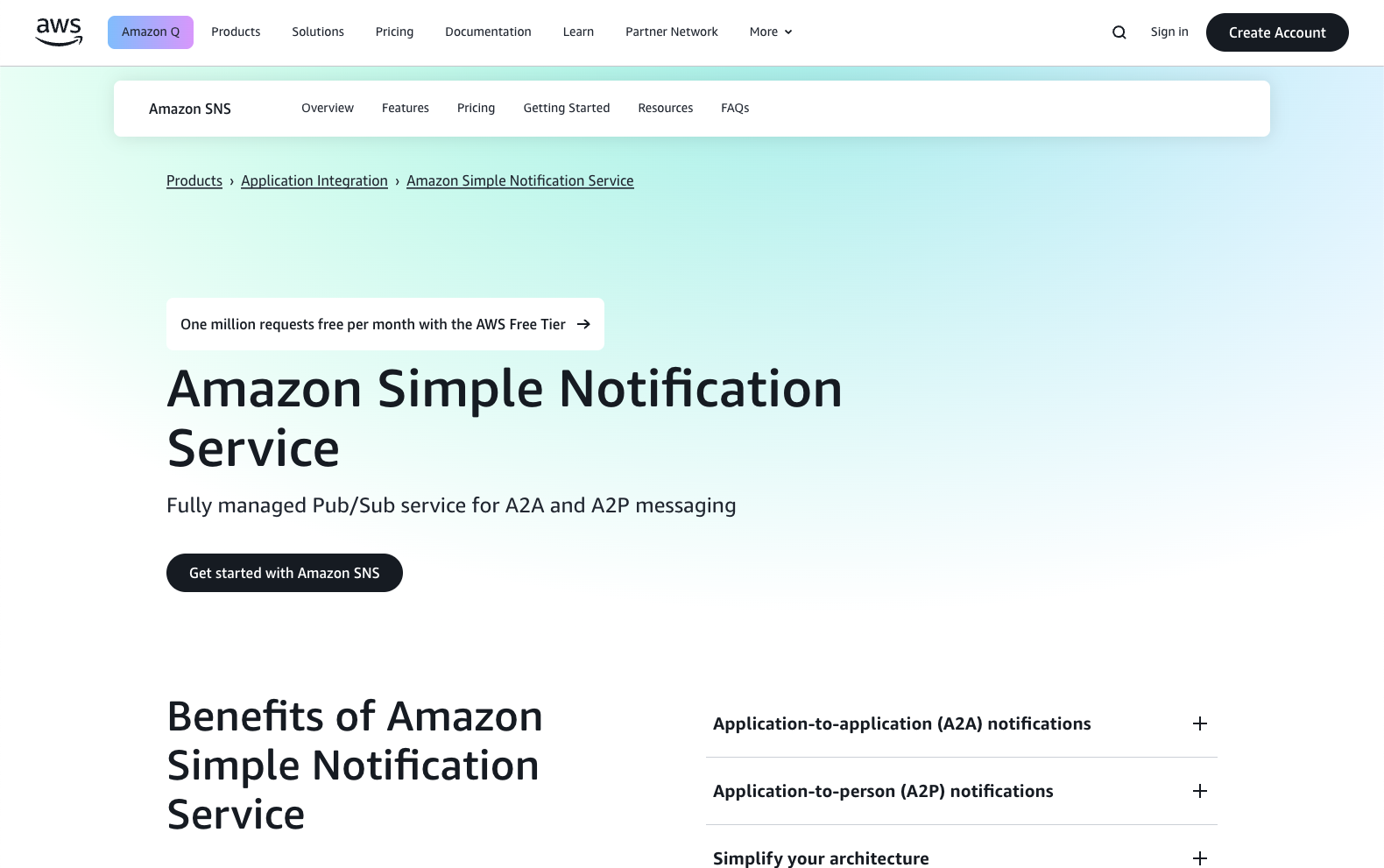
Amazon SNS (Simple Notification Service) is built for basic, one-way messaging use cases like alerts, transactional notifications, and bulk sends. The service supports both transactional and promotional message types, dedicated origination numbers (long codes, short codes, toll-free), and sender IDs where permitted.
Developer experience
If you're already an AWS customer, documentation will be familiar and integration is straightforward through the SDK or REST API. You can send messages by publishing to an SNS topic or directly to phone numbers, set per-message attributes like type, TTL, and sender ID, and monitor performance through CloudWatch metrics. Outside the AWS ecosystem, setup gets complex and observability will be limited.
Key features
- Native integration with Lambda, CloudWatch, S3, and other AWS services
- Global SMS delivery to most international destinations
- Message attributes for type (transactional/promotional) and TTL
- CloudWatch metrics for monitoring failures and spend
- Infrastructure as code via CloudFormation or Terraform
- Part of a broader notification platform (email, push, etc.)
Trade-offs
Amazon SNS lacks features that messaging-focused providers offer, such as contact management, templates, campaign tools, 10DLC compliance, or toll-free numbers in the US.
Up until recently, customers have used Amazon Pinpoint for its engagement capabilities (endpoints, segments, campaigns, journeys, and analytics) and messaging channel APIs (SMS, MMS, push, WhatsApp, and text to voice messaging capabilities), but Amazon has announced Pinpoint’s end of support as of October 30, 2026.
Pricing
With Amazon SNS, there is no minimum fee and you pay only for what you use. In the US, users pay $0.50 per 1 million Amazon SNS Requests, $0.06 per 100,000 notification deliveries over HTTP, and $2.00 per 100,000 notification deliveries over email.
The price for sending SMS messages varies by destination country. In some cases, the price also includes a telecom carrier fee for the destination phone number. For some countries, to successfully send SMS messages, you are required to purchase and use dedicated origination identities.
Note there will be additional costs for data transfer, message filtering, message archiving & reply, and message data protection.
See more pricing details on the pricing page.
Bottom line
SNS works best for AWS-native applications that just need to add simple outbound SMS. Per‑message delivery status can only be streamed to CloudWatch Logs or S3, so you need to be part of the AWS ecosystem. For standalone, non-Amazon SMS operations, look elsewhere.
How to integrate Amazon SNS with Knock
Knock allows you to build cross-channel messaging workflows and deliver SMS notifications to downstream providers like Amazon SNS. If you use Amazon SNS for SMS and want to manage SMS delivery through Knock, check out how to integrate Amazon SNS with Knock.
Sinch
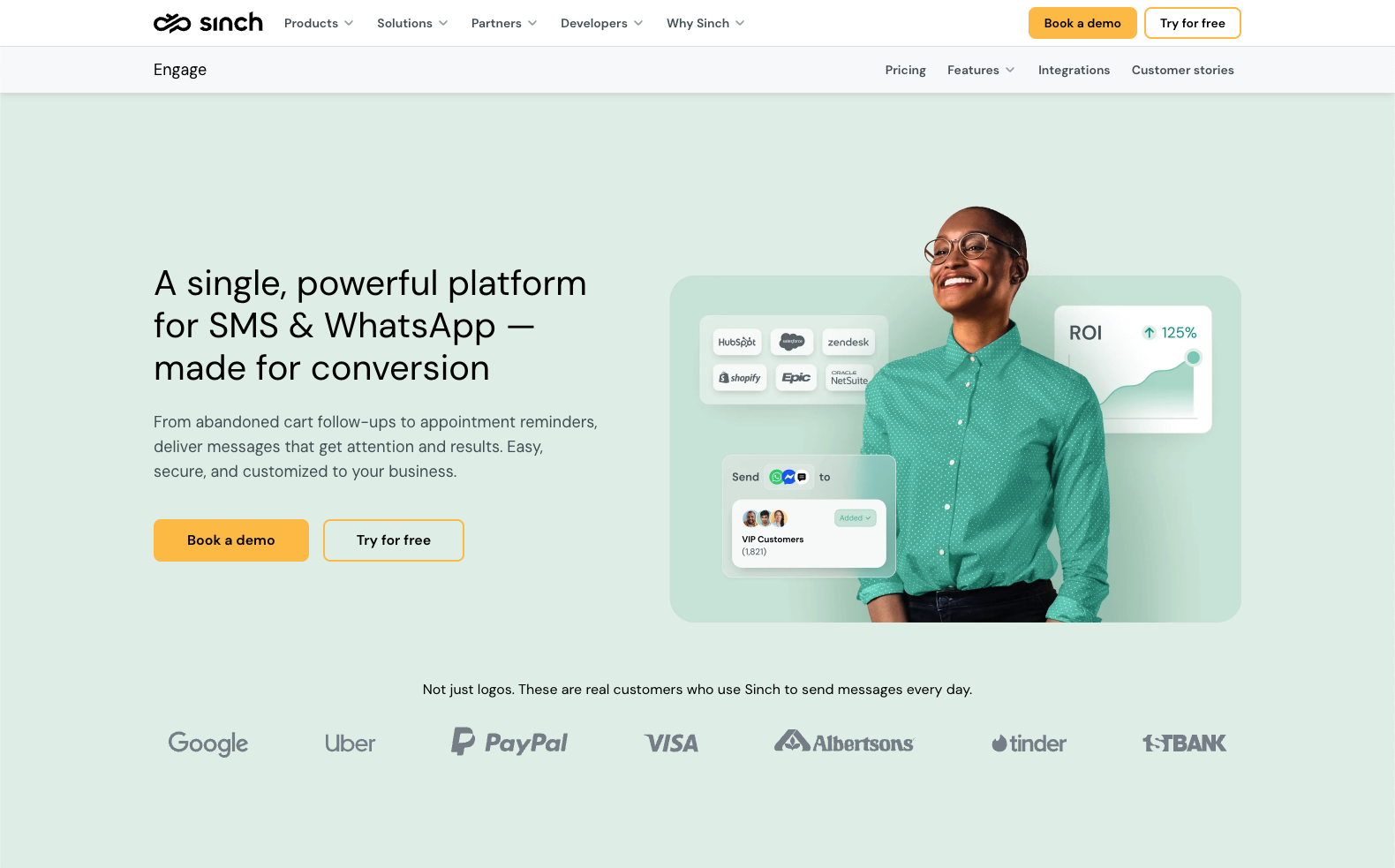
Sinch built its SMS network through acquisitions (CLX, Mblox, and others) to become a tier-1 aggregator in many countries. They own SS7 connectivity and maintain direct carrier relationships rather than reselling others' routes. The platform supports all standard sender types - short codes, long codes, toll-free, and alphanumeric IDs - with features like concatenation, delivery receipts, and 24/7 firewall monitoring to optimize termination rates.
Developer experience
The platform evolved from enterprise SOAP/REST interfaces toward modern APIs, but still carries that enterprise DNA. Developers report setup taking longer than consumer-focused alternatives like Twilio. Documentation exists, but leans technical rather than tutorial-driven. The self-service dashboard at cloud.sinch.com lets you get API keys and start sending, but the experience assumes enterprise integration knowledge. Large accounts get dedicated support engineers while smaller customers have to rely on standard documentation.
Key features
- Direct carrier access and SS7 connectivity in many regions
- Unified Conversation API for SMS, WhatsApp, RCS, and other channels
- Enterprise-grade monitoring and SMS firewall services
- Phone number procurement and management globally
- Sinch Verify for OTP, Sinch Engage for campaigns
- Integration with contact center and CRM systems
- AI-driven conversation tools through acquisitions
Trade-offs
The enterprise focus can create friction for smaller users. Support quality varies by account size, with large enterprises getting responsive, dedicated teams and smaller customers feeling neglected. Pricing lacks transparency, often requiring sales negotiations and minimum commitments.
Meanwhile, the platform's comprehensive features - SMS firewalls, authentication systems, telecom-grade routing - add complexity for basic use cases, and community resources are sparse compared to developer-friendly alternatives.
Pricing
Sinch pricing targets high-volume senders who can negotiate bulk discounts, which can make the effective cost be below or above Twilio, depending on messaging route and volume. Pricing for more advanced features requires contacting sales.
See more pricing details on the pricing page.
Bottom line
Sinch excels at enterprise-scale messaging where direct carrier relationships, compliance expertise, and multi-channel capabilities justify the complexity. It can be a valuable solution for banks sending millions of OTPs, carriers managing subscriber communications, or enterprises needing unified messaging across SMS, WhatsApp, and voice find value here. For startups or developers wanting simple SMS integration, the enterprise overhead may not be worth it.
How to integrate Sinch with Knock
Knock allows you to build cross-channel messaging workflows and deliver SMS notifications to downstream providers like Sinch. If you use Sinch for SMS and want to manage SMS delivery through Knock, check out how to integrate Sinch with Knock.
Bird (formerly MessageBird)
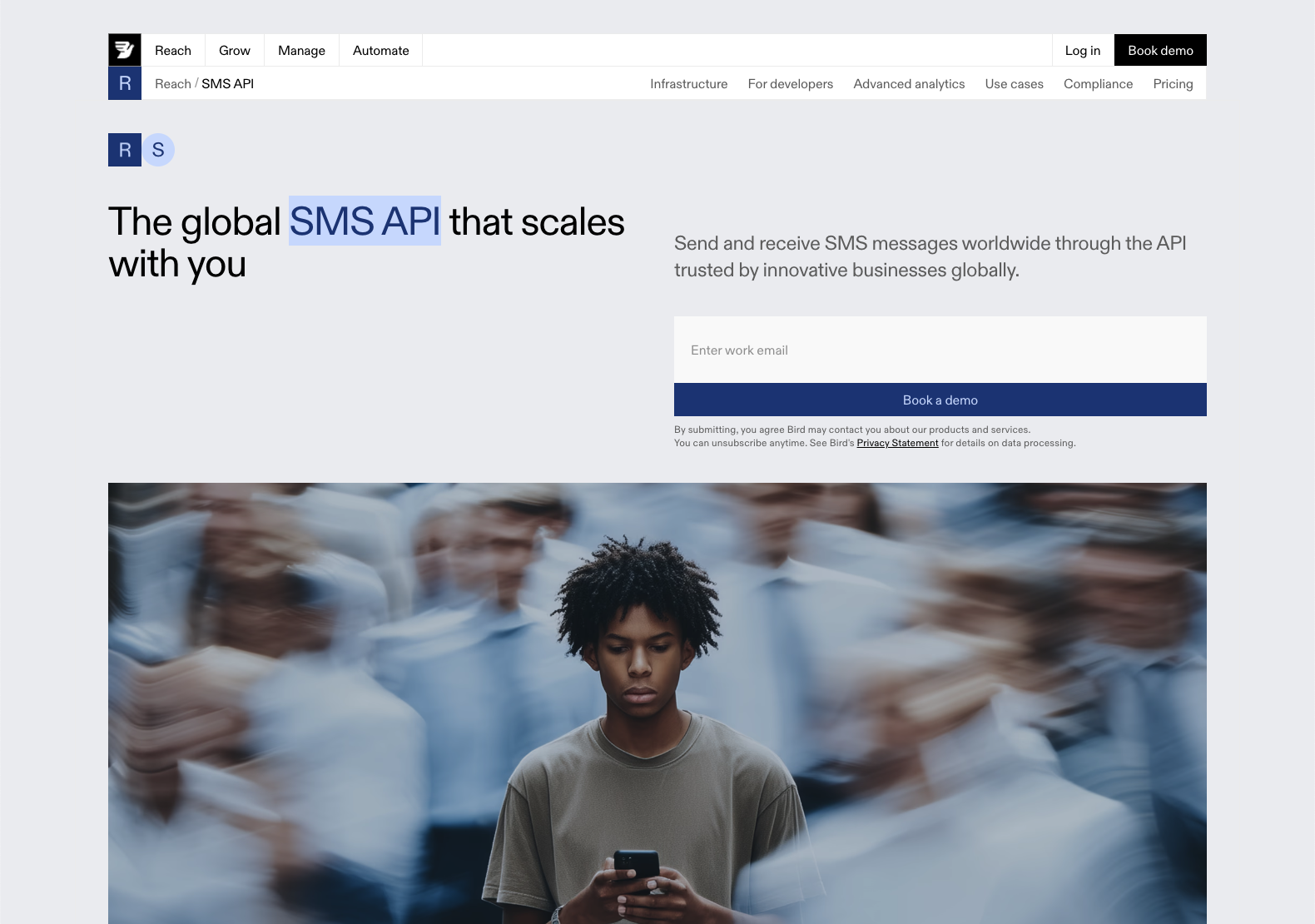
Bird (formerly MessageBird) is an omnichannel engagement platform with an SMS infrastructure that supports global two-way messaging with long codes, short codes, and sender IDs. They unify SMS, WhatsApp, email, and voice in one interface with visual workflow builders and CRM-like features to push beyond basic messaging APIs.
Developer experience
RESTful APIs and SDKs mirror Twilio's approach, making migration straightforward. Official libraries cover popular languages with decent API documentation. The visual Flow Builder lets non-developers create complex messaging logic without code - useful for marketing teams but less relevant for pure API users. Documentation covers the basics well but lacks depth for complex scenarios. Support skews toward enterprise clients while smaller developers rely on documentation.
Key features
- Drag-and-drop Flow Builder for visual workflow creation
- Unified Conversations API switching between channels
- Built-in fallback logic (try SMS, then WhatsApp, etc)
- AI chatbot builder and contact management
- Campaign management and marketing automation tools
- Global carrier connections with European strength
Trade-offs
The platform's breadth dilutes its focus on SMS. While Bird handles multiple channels well,SMS features like detailed error codes and debugging tools lag behind Twilio. The shift from developer-focused APIs to a broader engagement platform adds complexity for developers just wanting SMS capabilities.
While basic SMS is cheap, the full platform with CRM features, campaign management, and chatbot tools can push you into higher tiers with additional fees. Documentation quality and support responsiveness don't match Twilio's standards, particularly for smaller accounts.
Pricing
Bird's SMS API offers low per-message costs to undercut providers like Twilio. In the US, SMS messages start at $0.00331 for outbound messages and $0.003 for inbound.
SMS pricing varies by country, so it’s best to refer to the pricing page and find each country your company will support to estimate your potential costs.
Bottom line
Bird works best for teams needing unified messaging across channels with visual workflow tools. The rock-bottom SMS pricing attracts high-volume senders, while the omnichannel capabilities appeal to businesses managing customer engagement across multiple touchpoints. Pure developers seeking robust SMS-only APIs might find the platform creates unnecessary overhead.
How to integrate Bird with Knock
Knock allows you to build cross-channel messaging workflows and deliver SMS notifications to downstream providers like Bird. If you use Bird for SMS and want to manage SMS delivery through Knock, check out how to integrate Bird with Knock.
Vonage (formerly Nexmo)
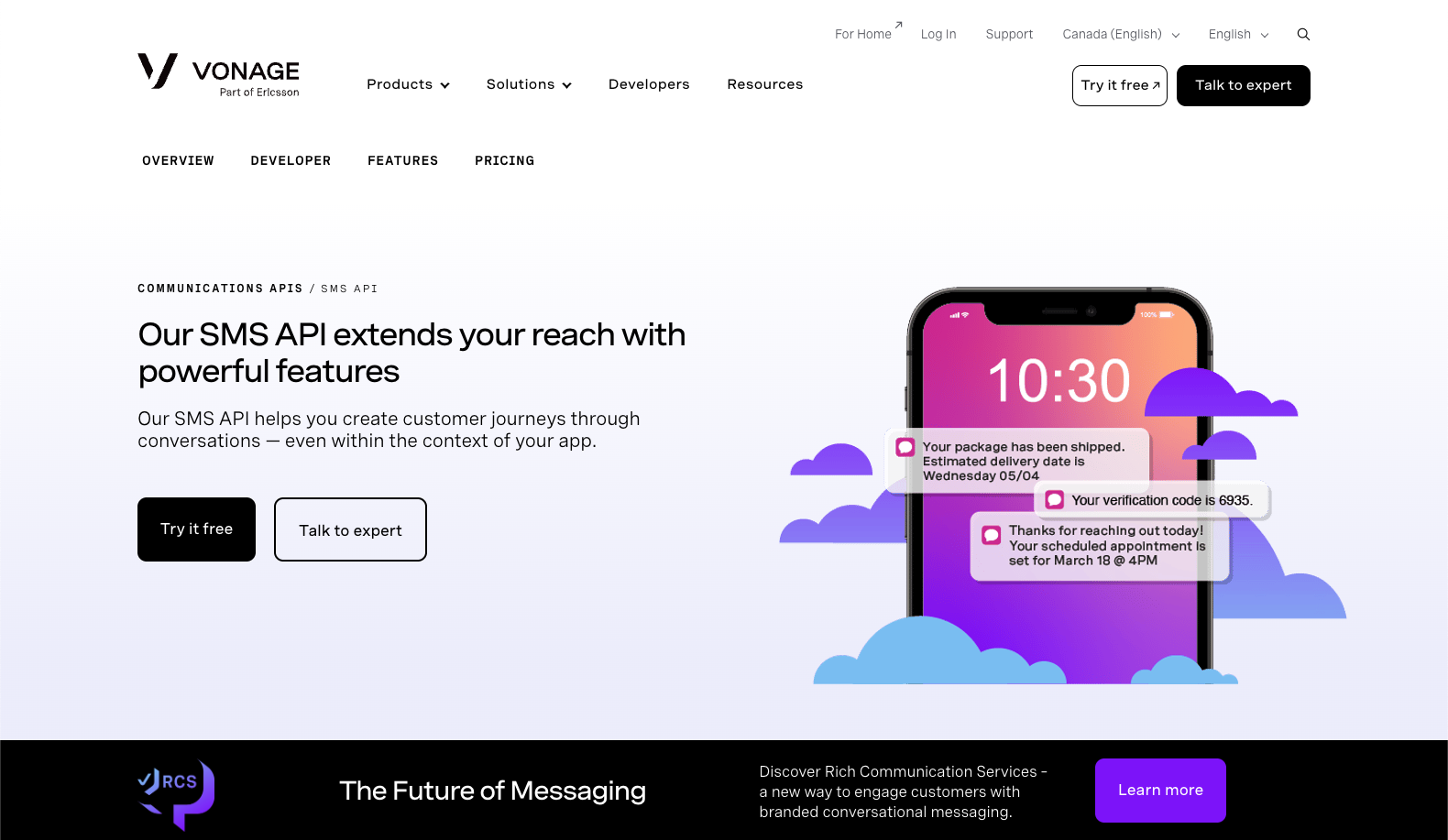
Vonage (formerly Nexmo) built its reputation focusing on straightforward APIs and competitive pricing. Combined with adaptive routing that automatically switches between carriers to avoid congestion, Vonage delivers consistent performance at low costs, plus unique features like built-in verification APIs.
Developer experience
The API follows simple JSON-over-HTTP patterns - one POST request sends an SMS. SDKs cover major languages (Node, Python, Java, .NET, Ruby) with decent documentation, including cURL examples. While functional, the docs lack interactive tutorials and comprehensive guides. The developer portal includes basic tutorials and a community forum, but the ecosystem is smaller. Developers praise the quick setup, though the platform offers fewer bells and whistles than competitors.
Key features
- Adaptive routing with automatic carrier failover
- Verify API for automated 2FA/OTP flows
- Number Insight API for carrier lookup and validation
- Messages API supporting WhatsApp, Facebook Messenger, Viber
- Per-second voice billing (shows developer-friendly pricing approach)
Trade-offs
Vonage’s documentation quality trails market leaders. While adequate for basic integration, complex scenarios may require more digging or support tickets.
Platform analytics remain basic, providing only delivery receipts and usage logs without the detailed insights or ML-driven optimizations some competitors offer. Dashboard tools are minimal, requiring custom development for advanced campaign management or detailed reporting.
The fee structure, while generally cheaper, still includes compliance costs and special requirements for short codes or high-volume US messaging. Premium support locks essential features like 24/7 phone access behind expensive contracts. Smaller users report that complex issues can take time to resolve without paid support tiers.
Pricing
In the US, outbound SMS cost $0.00846, while incoming messages cost $0.00679 per message. Like others, Vonage passes through 10DLC carrier fees for US A2P messaging. There is a free trial, but sending to verified numbers is restricted until upgrade. Support tiers range from free email/web during business hours to Premier support with 24/7 phone access starting at $3,300/month.
See more pricing details on the pricing page.
Bottom line
Vonage suits developers seeking reliable, cost-effective SMS with global reach. Teams needing advanced analytics, extensive documentation, or sophisticated campaign tools might find the platform too bare-bones. But for straightforward SMS at competitive prices with solid reliability, Vonage delivers exactly what many developers need.
How to integrate Vonage with Knock
Knock allows you to build cross-channel messaging workflows and deliver SMS notifications to downstream providers like Vonage. If you use Vonage for SMS and want to manage SMS delivery through Knock, check out how to integrate Vonage with Knock.
MessageMedia
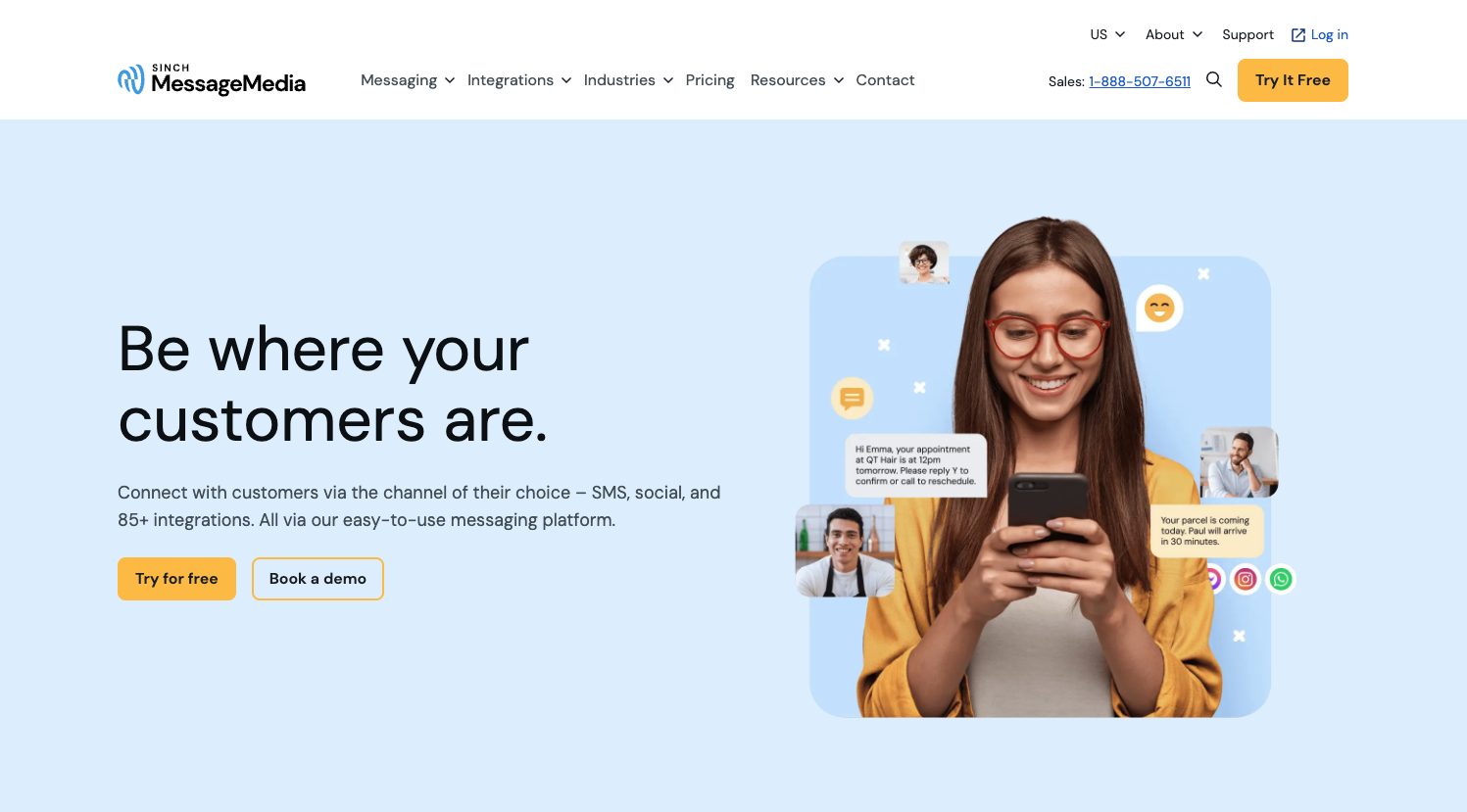
MessageMedia, now part of Sinch, built its platform exclusively around SMS and MMS, targeting businesses rather than developers. The Australian company focuses on making SMS accessible to marketing teams, healthcare providers, and logistics companies who need reliable messaging without complex integration. Unlike API-first providers, MessageMedia includes visual dashboards, message templates, and campaign tools that business users can operate directly.
Developer experience
REST API with SDKs for Python, PHP, Java, .NET, Node, and Ruby covers the technical basics. The API handles single or bulk sends, delivery status checks, webhook reception, and template management. Documentation is clean with API explorer tools. Integration is straightforward and stable, though the developer ecosystem is smaller than major competitors.
Key features
- Visual inbox for managing two-way conversations
- Built-in automation rules and triggers
- Message personalization and template library
- Keyword handling for auto-replies and opt-outs
- SMS scheduling and campaign management
- Native integrations with HubSpot, Salesforce, Shopify
- Email forwarding for SMS replies
- Managed 10DLC compliance
Trade-offs
The platform lacks advanced telecom features - no SIP trunking, programmable voice, or custom short code provisioning. Campaign workflows require using the UI rather than programmatic control, limiting automation possibilities. The smaller developer community means fewer third-party resources and examples.
Platform limitations emerge in complex scenarios. No Twilio-style flow builders or advanced routing logic. The focus on business users over developers means certain technical capabilities are simplified or absent. Scale pricing, while available, doesn't match the aggressive rates of pure infrastructure providers.
Pricing
In the US, outbound SMS costs $0.04 per message, plus carrier surcharges of $0.0025-$0.0050. Inbound messages incur the same carrier fees on most US networks. Custom enterprise quotes are available for those sending more than 40,000 monthly messages.
Dedicated number pricing isn't published for the US market, but Australian pricing ranges from AU$42-$749 per month. Support tiers range from free Standard to Platinum at $700/month.
See more pricing details on the pricing page.
Bottom line
MessageMedia excels when business teams need reliable SMS without developer involvement, great for when simplicity and support matter more than price per message. For pure API integration or complex telephony needs, developer-focused alternatives offer more flexibility at lower costs.
How to integrate MessageMedia with Knock
Knock allows you to build cross-channel messaging workflows and deliver SMS notifications to downstream providers like MessageMedia. If you use MessageMedia for SMS and want to manage SMS delivery through Knock, check out how to integrate MessageMedia with Knock.
Plivo
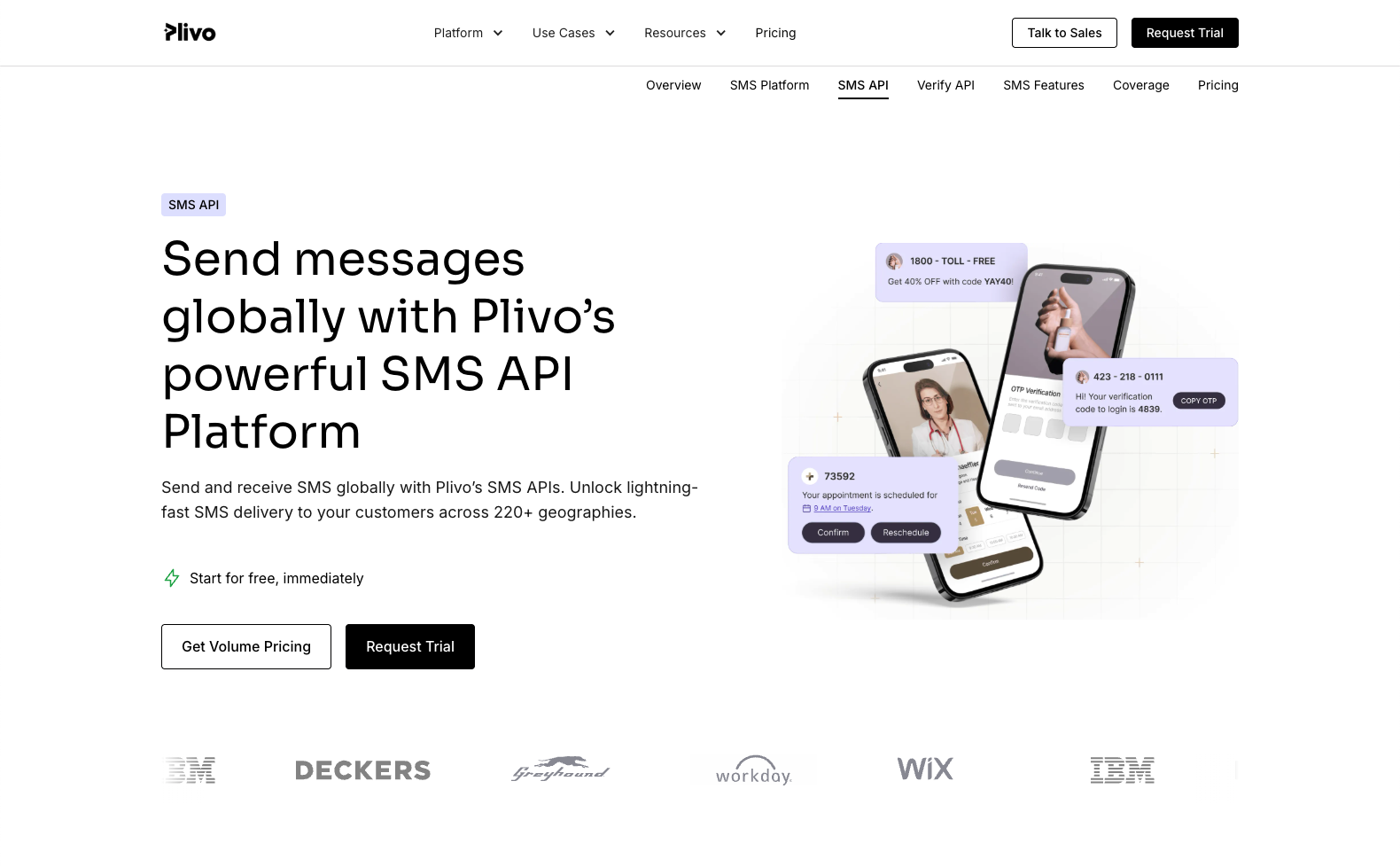
Plivo delivers reliable SMS to more than 190 countries through direct carrier connections, supporting all standard features like long codes with 10DLC registration, toll-free numbers, short codes, and alphanumeric sender IDs. Auto-concatenation, Unicode support, two-way messaging with delivery reports, and bulk sending work as expected. Beyond core SMS, Plivo offers WhatsApp Business API integration and PHLO, a visual workflow builder for creating SMS and voice flows without code. Their Verify API adds OTP functionality without per-verification fees beyond SMS costs.
Developer experience
The API mirrors Twilio's design intentionally, making migration straightforward. SDKs cover Python, Java, Node.js, Ruby, PHP, .NET with clear, concise documentation. Code examples for each endpoint get you sending messages in minutes. The console provides test messaging, number management, and logs. Webhooks handle status updates and incoming messages. Security features include auth tokens, IP whitelisting, and two-factor authentication. Email support comes standard with faster SLAs for higher-spend accounts. A community Slack and knowledge base round out the resources.
Key features
- 99.99% uptime SLA matching enterprise standards
- Smart routing across direct carrier connections
- Built-in debugger for delivery issues
- Automatic volume discounts
- Simple Verify API for OTP without extra fees
- Familiar API design for easy Twilio migration
- Focus on core SMS/voice without feature bloat
Trade-offs
The narrow focus that keeps costs low also creates limitations. Plivo has no native support for WhatsApp, Facebook Messenger, or other channels beyond SMS and voice, and doesn’t support advanced features like visual workflow builders, AI-driven personalization, or sophisticated campaign tools. The web dashboard is functional but not polished for managing large number inventories or detailed analytics.
Additionally, community resources are sparse compared to Twilio. Fewer blog posts, Stack Overflow answers, and third-party tutorials mean more self-reliance when troubleshooting edge cases. Certain enterprise features like SSO, granular role-based access, or pre-built integrations with Salesforce and Zendesk don't exist. Plivo provides the APIs, and you build everything else.
Pricing
Plivo is a pay-as-you-go service with no minimums or monthly fees. In the US, outbound SMS starts at $0.007 per message, and inbound messges are free, with volume discounts available for high monthly usage. The platform passes through 10DLC fees but includes tools to simplify campaign registration.
See more pricing details on the pricing page.
Bottom line
Plivo excels for developers who need reliable SMS infrastructure at the lowest possible cost. The straightforward API and familiar design patterns mean quick integration without surprises, but don't expect much support or any bells and whistles.
How to integrate Plivo with Knock
Knock allows you to build cross-channel messaging workflows and deliver SMS notifications to downstream providers like Plivo. If you use Plivo for SMS and want to manage SMS delivery through Knock, check out how to integrate Plivo with Knock.
Telnyx
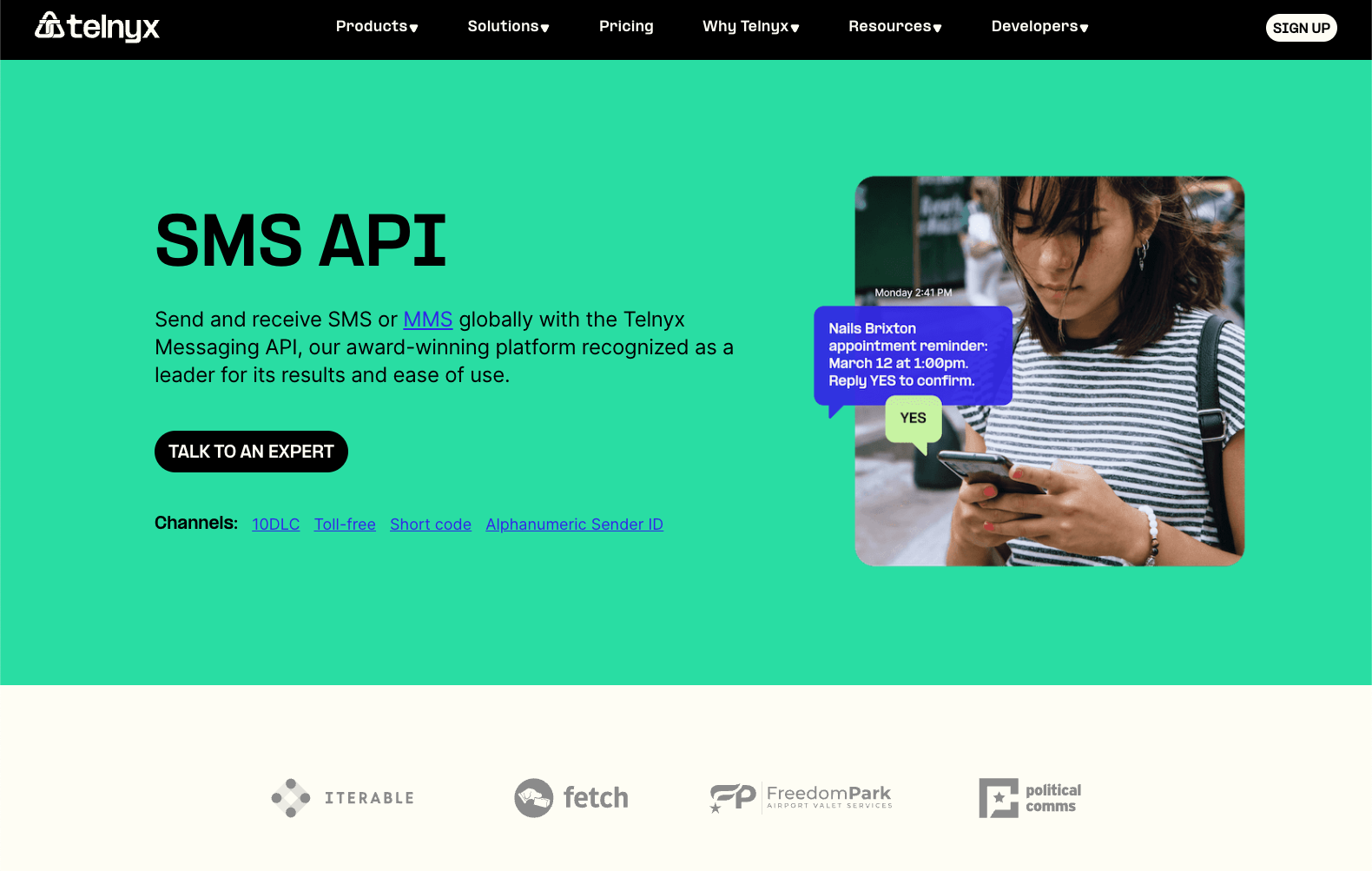
Telnyx built its platform as a developer-friendly Twilio alternative with infrastructure advantages. The SMS service reaches more than 180 countries, supporting 10DLC long codes, toll-free numbers, short codes, and alphanumeric sender IDs. Telnyx allows 10 messages per second per long code by default, compared to Twilio's typical 1 MPS, which is perfect for time-sensitive bulk messaging.
Developer experience
APIs follow familiar JSON patterns, making Twilio migration straightforward. SDKs exist for Python, Java, .NET, Node, though the ecosystem is smaller. The Mission Control Portal handles number provisioning, messaging profiles, and real-time monitoring. Documentation is thorough and intuitive, and there is free 24/7 live support via chat or phone with actual engineers.
Key features
- Private fiber network reducing latency and improving control
- Higher throughput available with 10DLC vetting
- Real-time delivery status and webhooks
- Number pooling and concatenated SMS/MMS support
- Built-in number lookup and verification APIs
- Self-serve number porting and management
- Automatic volume discounts at scale
Trade-offs
Initial setup requires some background into telecom concepts like SIP trunking, messaging profiles, and 10DLC compliance configuration.
The smaller ecosystem means fewer third-party tutorials, plugins, and community answers. You'll rely more on official documentation and support. Some high-volume users report occasional latency during peak periods, though this isn't widespread.
Pricing
In the US, SMS costs $0.004 per message for both outbound and inbound, roughly half Twilio's rates. Telnyx offers pay-as-you-go pricing with no monthly minimums and automatic tiered discounts starting above 100M messages/month. Carrier fees for A2P messaging pass through, but base rates remain aggressive. All accounts include free 24/7 support via chat or phone.
See more pricing details on the pricing page.
Bottom line
Telnyx excels for developers who value performance and cost over ecosystem size. The combination of owned infrastructure, 10x higher throughput, half-price messaging, and free expert support creates compelling value. Applications that require consistent, low latency or need to send time-sensitive notifications benefit most from Telnyx's infrastructure advantages. Just be prepared for a steeper learning curve.
How to integrate Telnyx with Knock
Knock allows you to build cross-channel messaging workflows and deliver SMS notifications to downstream providers like Telnyx. If you use Telnyx for SMS and want to manage SMS delivery through Knock, check out how to integrate Telnyx with Knock.
Africa's Talking
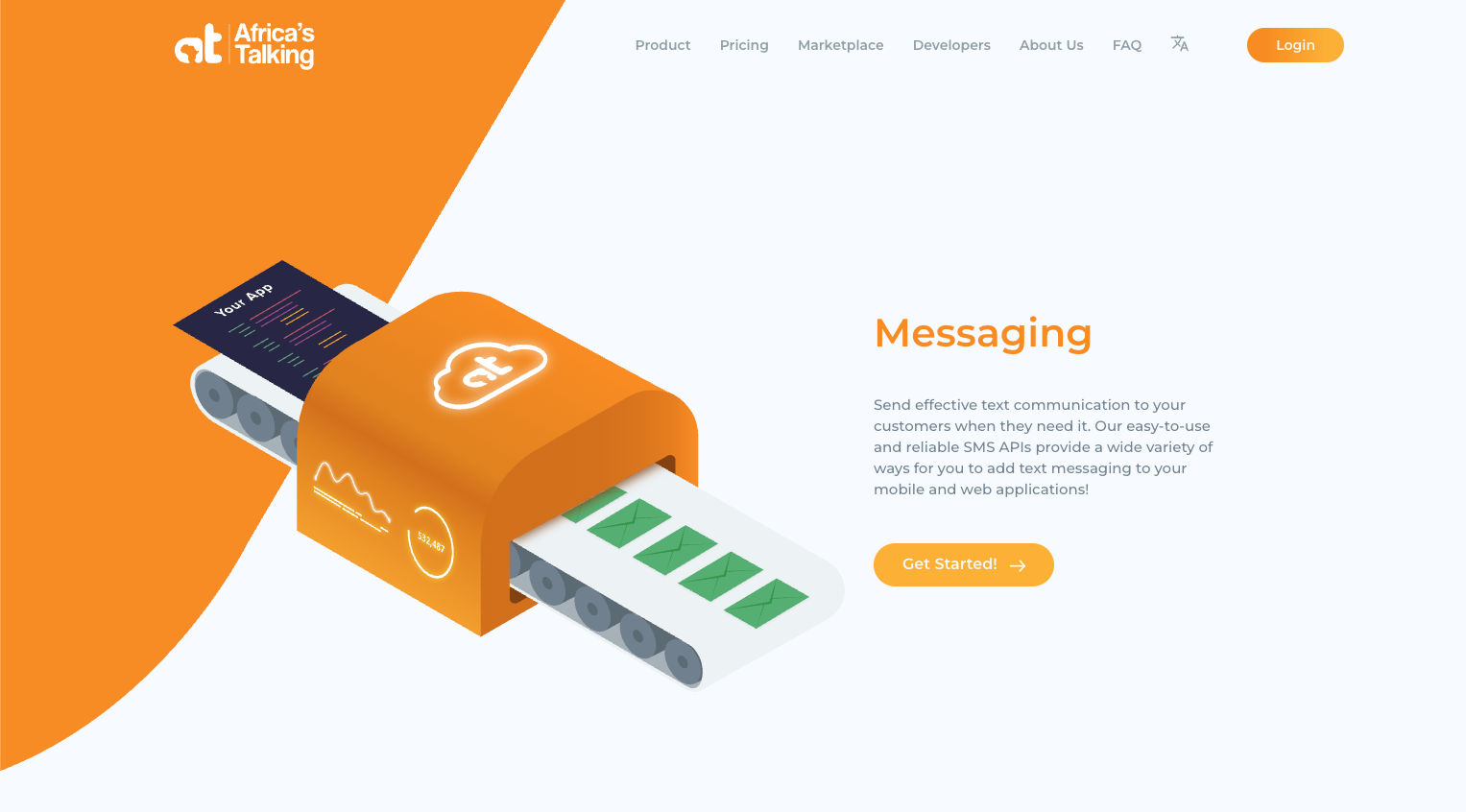
Africa's Talking solves the problem of SMS providers charging exorbitant international rates (especially in Africa) and not understanding local telecom complexities. By negotiating directly with African carriers and building region-specific infrastructure, Africa’s Talking delivers SMS at roughly 10x lower cost than other providers while handling local regulations, sender ID requirements, and carrier quirks.
Developer experience
The platform has earned a great reputation through exceptional documentation and local developer support. SDKs cover Python, JavaScript, PHP, Java, .NET with thorough tutorials and sample code. A sandbox environment allows testing without burning credits, and integration takes minutes: create an account, get an API key, start sending. The team responds via email or even WhatsApp, and invests heavily in community through hackathons, forums, and meetups, creating a support network of developers who understand African-specific challenges.
Key features
- Bulk SMS API sending to thousands with one call
- Two-way messaging with short codes or virtual numbers
- Alphanumeric sender IDs where supported
- Delivery reports and message history
- Complementary APIs: USSD, Airtime top-up, Mobile Money payments
- Local carrier relationships in Kenya, Uganda, Nigeria, South Africa, and more
- Handles country-specific compliance and regulations
Trade-offs
The regional focus that makes Africa’s Talking excellent for Africa limits global utility. Sending outside African markets uses expensive international routes at $0.04 per message. Coverage gaps exist even within Africa. Feature set remains basic compared to global providers, including no Conversations API, limited analytics, and no WhatsApp or email channels. You get reliable SMS delivery, not fancy multi-channel orchestration.
Throughput constraints can affect massive campaigns. Local carrier connections may bottleneck high-volume bursts that global providers handle through distributed infrastructure. The simple dashboard lacks detailed debugging tools - failed messages show basic error codes without rich explanations. Dependence on local infrastructure means less redundancy when specific carriers have issues.
Pricing
Africa’s Talking is pay-as-you-go with no monthly fees, no minimums, and SMS credits never expire. Country-specific pricing in local currency makes costs predictable. In Kenya, SMS costs range from KES 0.8 (~$0.0053) per message for low volume down to KES 0.4 ($0.0027) per message at high volume, beating Twilio’s $0.2009 per message cost in Kenya. However, international messages outside AT's primary markets cost $0.04. Volume discounts apply automatically within each country.
See more pricing details on the pricing page.
Bottom line
Africa's Talking excels for developers who need to send high volumes of SMS messages within Africa. The combination of local expertise, 10x cost savings, and a developer-friendly approach makes it the obvious choice for SMS within the continent. Just don't expect it to handle your global SMS needs or provide advanced features beyond core messaging.
How to integrate Africa’s Talking with Knock
Knock allows you to build cross-channel messaging workflows and deliver SMS notifications to downstream providers like Africa’s Talking. If you use Africa’s Talking for SMS and want to manage SMS delivery through Knock, check out how to integrate Africa’s Talking with Knock.
Mailersend
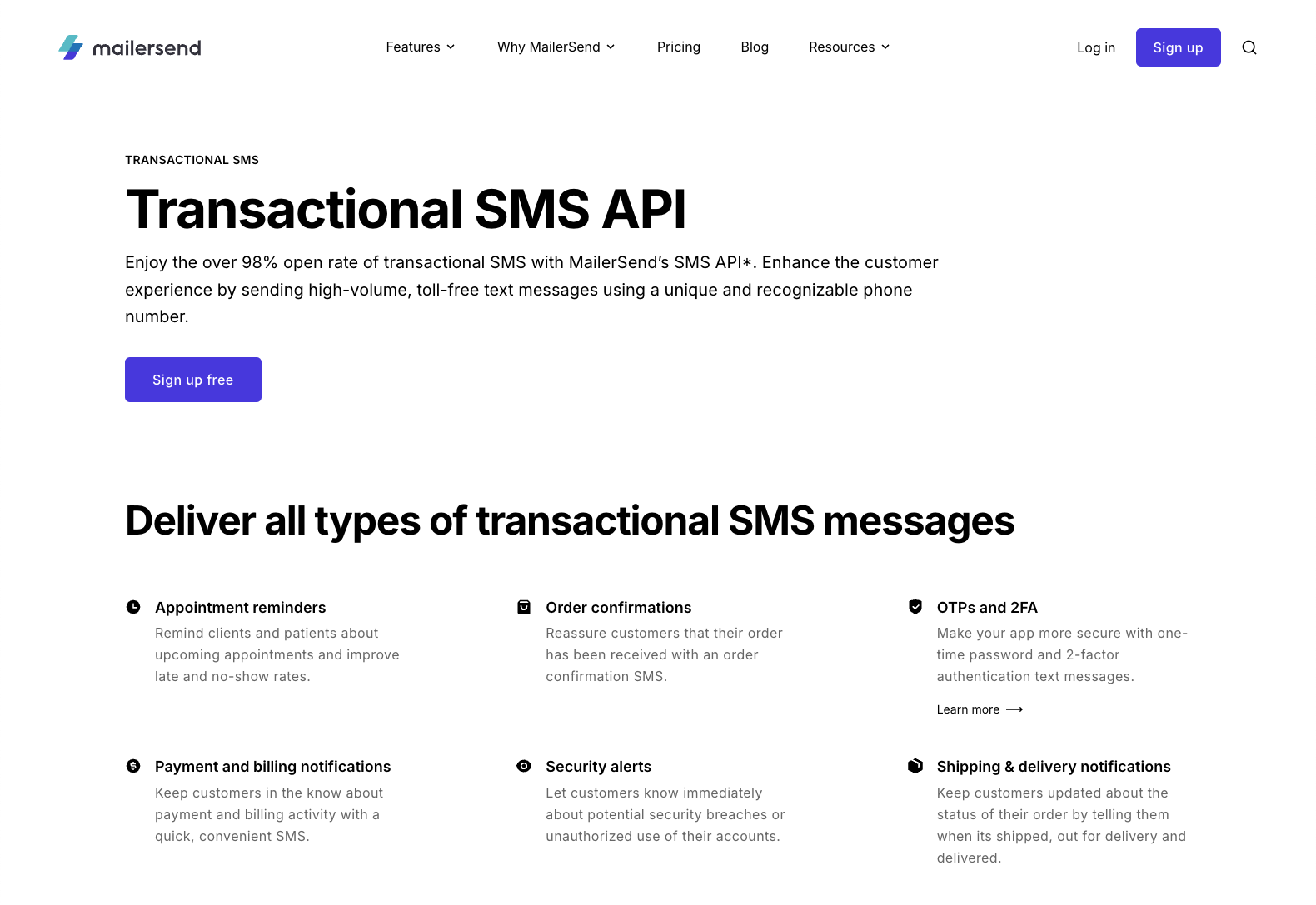
Known for developer-friendly transactional email, MailerSend added SMS to its platform in late 2022. The SMS feature integrates seamlessly with their email infrastructure, sharing the same dashboard, templates, and API patterns. This makes sense for their target market: developers already sending transactional emails who occasionally need SMS for critical notifications.
Developer experience
The unified API handles both email and SMS through consistent JSON endpoints. If you've integrated MailerSend for email, adding SMS requires minimal effort. SDKs cover major languages with a single library for both channels, and its documentation earns praise for clarity and thoughtful implementation. Webhooks notify about deliveries and replies, while Zapier integration enables no-code workflows. The dashboard provides straightforward management of templates, logs, and phone numbers without telecom complexity.
Key features
- Two-way messaging with inbound routing rules
- Bulk SMS endpoint for batch sending
- Message personalization using email-style templates
- Transactional-only (no marketing SMS allowed)
- Currently North America only (US and Canada)
- Toll-free numbers for sending/receiving
- Unified dashboard for email and SMS
- Webhook notifications for replies
Trade-offs
As an add-on functionality, SMS through Mailersend is less established and doesn’t support several advanced features. Importantly, users can’t send messages outside of North America, plus a transactional-only policy restricts SMSmarketing campaigns. Toll-free numbers lack the local presence of standard numbers and might appear less personal to recipients, and no short codes or 10DLC local numbers may limit high-volume senders.
At $0.014 per message, MailerSend’s pricing doesn't favor SMS-heavy usage as costs will add up quickly compared to dedicated providers. The plan structure also forces you to pay for email even if you only need SMS.
Pricing
Mailersend’s SMS pricing bundles into several subscription plans alongside email. There is a free tier, but it doesn’t include any SMS, only email. The Starter plan includes 100 SMS monthly, with overages at $1.40 per 100 messages ($0.014 per SMS), more expensive compared to other providers.
See more pricing details on the pricing page.
Bottom line
MailerSend excels for developers already using their email service who need occasional SMS for critical communications. The clean API and SMS credits in paid plans make it convenient for low-volume transactional messaging. Don't expect competitive pricing for high-volume SMS or global reach, as MailerSend optimizes for integration convenience, not scale.
How to integrate Mailersend with Knock
Knock allows you to build cross-channel messaging workflows and deliver SMS notifications to downstream providers like Mailersend. If you use Mailersend for SMS and want to manage SMS delivery through Knock, check out how to integrate MailerSend with Knock.
Choosing the best SMS provider for you
Choosing an SMS provider in 2026 comes down to matching your specific needs with the right platform strengths.
For pure developer experience and features, Twilio remains the gold standard, just be prepared to pay premium prices. Cost-conscious developers building at scale should consider Plivo or Telnyx, which deliver reliable infrastructure at half the cost. AWS-native teams will find Amazon SNS seamless for basic notifications, while MailerSend makes sense if you're already using it for email.
Regional considerations matter: Africa's Talking dominates the African market with unbeatable local pricing and expertise. MessageMedia and Bird excel when non-technical teams need to manage SMS campaigns through visual interfaces. Enterprise organizations requiring compliance expertise and multi-channel orchestration should evaluate Sinch or Vonage.
The best provider isn't necessarily the cheapest or most feature-rich - it's the one that aligns with your technical requirements, budget constraints, and growth trajectory. Start by evaluating your core needs: volume, geography, integration complexity, and support requirements. Then trial the best-fitting solutions before committing.
Using Knock to build messaging workflows with SMS
Adding SMS messaging to your product is a crucial step for modern applications. You’ll need one of the SMS services mentioned above to handle delivery, but before that, Knock bridges the gap on these features:
- Build and schedule multi-step SMS flows
- Create and maintain SMS notification templates
- Track delivery with advanced logic and logging
- Capture link-click engagement data
Before long, you may find yourself in the weeds building lots of different types of notifications across disparate channels. This is where Knock can help.
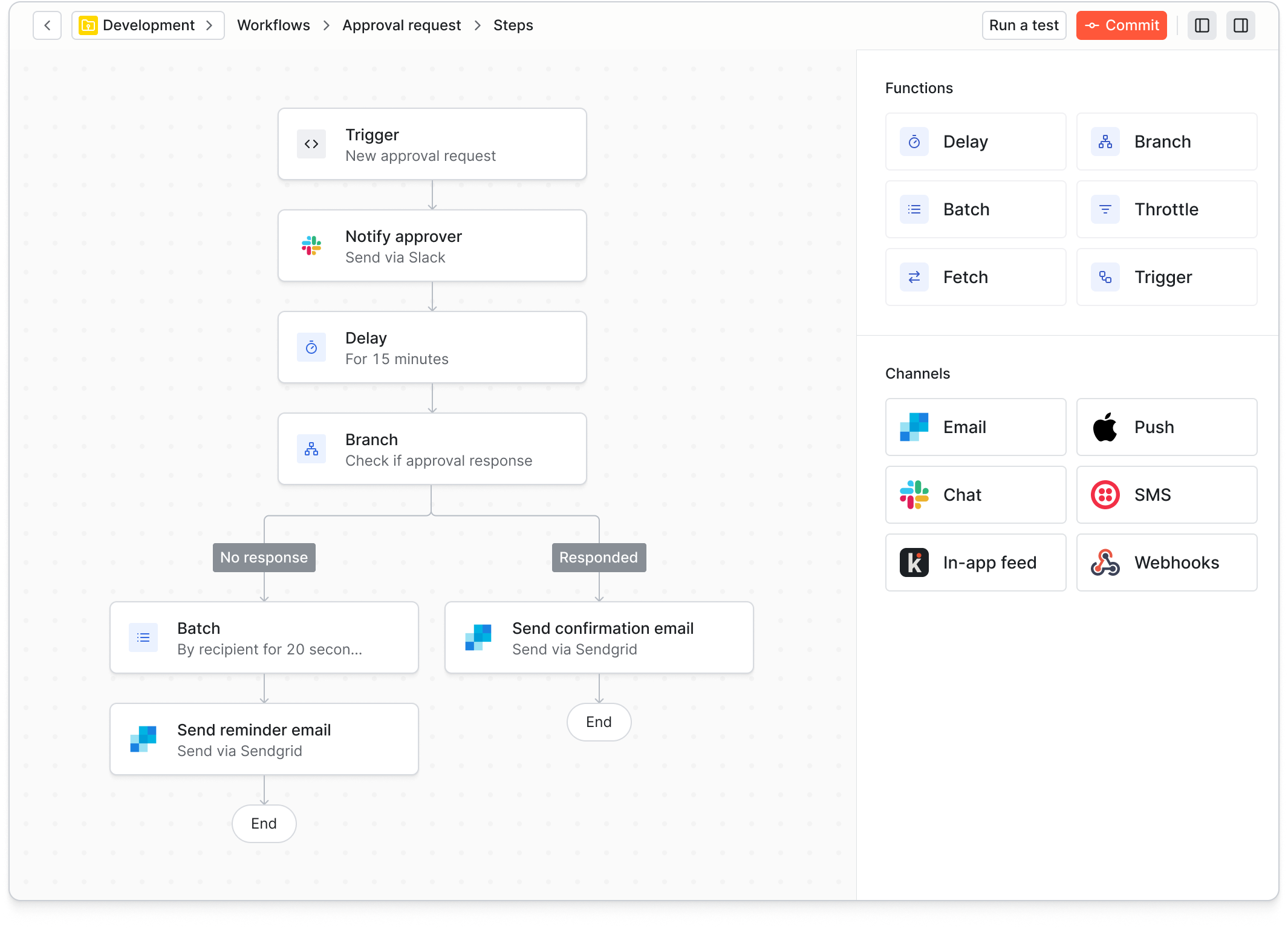
Knock is infrastructure for sending product and customer messaging across any channel, including email, push, SMS, and chat, with over 25 integrations and counting. Developers use Knock to create complex cross-channel messaging workflows without needing to build and maintain a complex notification system themselves.
Whether you’re planning to send notifications across many channels or only transactional emails, Knock can help. If you'd like to try it out, you can sign up for a free account or chat with our team. 👋